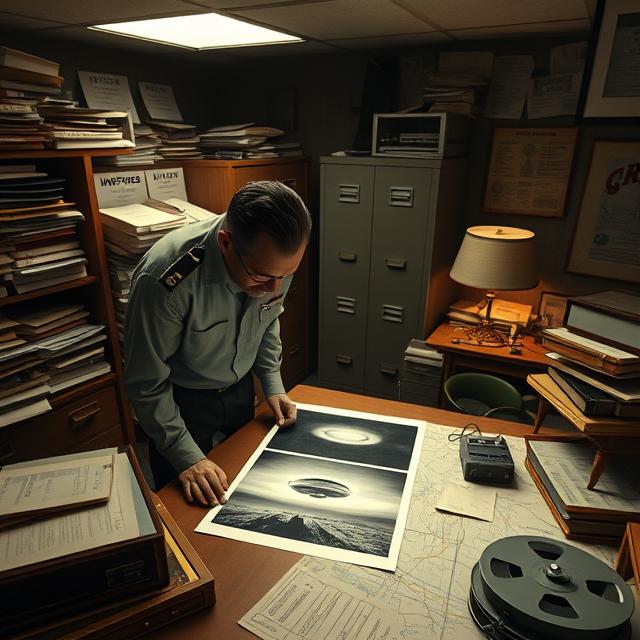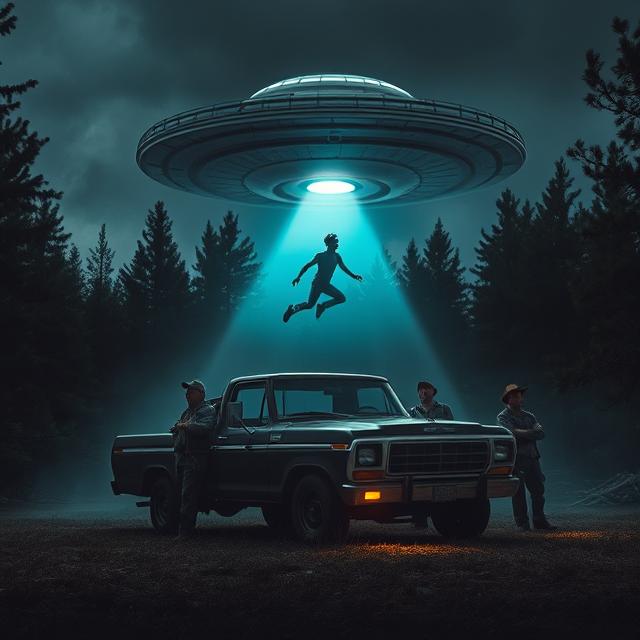For over two decades, at the height of the Cold War and the dawn of the Space Age, the United States Air Force was tasked with an extraordinary mandate: to investigate, analyze, and explain the burgeoning phenomenon of Unidentified Flying Objects. This official government endeavor, known to history as Project Blue Book, stands as the longest and most extensive public-facing UFO study ever conducted. From 1952 to 1969, its investigators sifted through thousands of reports of strange lights, mysterious craft, and aerial encounters that defied easy explanation.
Project Blue Book became the public’s primary point of contact with the government on the subject of UFOs, creating a complex legacy of official explanations, lingering mysteries, and accusations of a systematic cover-up. It was an institution that walked a fine line between national security concerns and scientific inquiry, all while navigating the treacherous waters of public fear and fascination. This is the definitive story of Project Blue Book, a deep dive into the government’s two-decade struggle with the enigma of the flying saucer.
The Dawn of the Saucer Age: Projects Sign and Grudge
The story of Project Blue Book begins not in 1952, but in the summer of 1947, a period that ignited the modern UFO era. On June 24, 1947, private pilot Kenneth Arnold reported seeing nine crescent-shaped objects flying at incredible speeds near Mount Rainier, Washington. His description of their movement, “like a saucer if you skip it across the water,” led the media to coin the iconic term “flying saucer.” Just weeks later, the alleged crash of a strange craft near Roswell, New Mexico, further fueled public and government interest.
In response to this wave of sightings, the U.S. Air Force established Project Sign at the end of 1947. Headquartered at Wright-Patterson Air Force Base in Ohio, its mission was to collect and evaluate UFO data to determine if there was a threat to national security. Initially, the project’s personnel were open to unconventional explanations. In the summer of 1948, they drafted a “Top Secret Estimate of the Situation” which, according to insiders like Captain Edward J. Ruppelt (who would later head Blue Book), concluded that the best explanation for the most compelling cases was the “interplanetary hypothesis”—that these objects were extraterrestrial in origin. However, this radical conclusion was rejected and suppressed by higher-ranking generals, and the “Estimate” was ordered destroyed.
Following this, the official attitude hardened. In 1949, Project Sign was dismantled and replaced by Project Grudge. As its name suggests, the new project operated under a debunking mandate. Its official report concluded that UFO reports were simply misidentifications of conventional objects, products of mass hysteria, or outright hoaxes. The goal was no longer to investigate but to publicly dismiss the phenomenon. This dismissive attitude, however, proved unsustainable as credible reports from pilots and military personnel continued to pour in.
The Blue Book Era: A New Approach?
By 1951, many high-ranking Air Force officials felt that the dismissive approach of Project Grudge was inadequate and potentially dangerous. In March 1952, Project Grudge was officially dissolved and reorganized into Project Blue Book. Its first director, Captain Edward J. Ruppelt, brought a new sense of professionalism and objectivity to the investigation. Ruppelt coined the term “Unidentified Flying Object” (UFO) to replace the more sensational “flying saucer” and established standardized procedures for collecting and analyzing sighting reports.
Project Blue Book had two primary, publicly stated goals:
- To determine if UFOs posed a threat to the national security of the United States.
- To scientifically analyze UFO-related data and determine if it contained any advanced technology or scientific principles beyond the range of contemporary knowledge.
A key figure throughout the entire history of the Air Force’s UFO studies was Dr. J. Allen Hynek, an astronomer from Ohio State University who was hired as Blue Book’s chief scientific consultant. Initially a deep skeptic, Hynek’s role was to identify which UFO reports could be explained by astronomical phenomena like meteors or bright planets. Over the years, however, his exposure to a steady stream of baffling and inexplicable cases from credible witnesses would slowly transform him from a debunker into a proponent of serious, continued scientific study of the phenomenon.
Famous Cases and Lingering Unknowns
Over its 17-year lifespan, Project Blue Book investigated 12,618 UFO sightings. The majority of these were officially explained as misidentifications of natural phenomena (stars, clouds, meteors), conventional aircraft (including secret spy planes like the U-2), weather balloons, or other mundane objects. However, a significant number of cases defied easy explanation and have become classics of UFO lore.
- The Mantell Incident (1948): Captain Thomas Mantell, a Kentucky Air National Guard pilot, was killed when his P-51 Mustang fighter plane crashed while in pursuit of a large, metallic, cone-shaped object. While Blue Book officially concluded that Mantell had misidentified the planet Venus and crashed due to a lack of oxygen at high altitude, many researchers still question this explanation.
- The Lubbock Lights (1951): Several professors from Texas Tech University photographed a series of V-shaped formations of lights flying over Lubbock, Texas. Blue Book’s investigation concluded the lights were likely caused by birds (plovers) reflecting the light of new street lamps, an explanation the witnesses found absurd.
- The Washington National Airport UFO Incident (1952): Over two consecutive weekends in July, numerous unidentified targets were tracked on radar screens at Washington National Airport and Andrews Air Force Base. The objects were also visually confirmed by pilots and ground personnel. F-94 Starfire jets were scrambled to intercept the objects, but the mysterious lights would either disappear or perform maneuvers at speeds unattainable by the jets. While Blue Book attempted to explain the event as a temperature inversion causing false radar returns, many of the radar operators and pilots involved rejected this conclusion.
These high-profile cases, along with hundreds of others, fell into Blue Book’s most intriguing category: the “Unidentified.” By the time the project was terminated, 701 cases remained officially unexplained.
Criticism, Controversy, and the Condon Report
Despite its official mission of scientific inquiry, Project Blue Book was plagued by criticism throughout its existence. Critics, including Dr. Hynek himself, argued that the project was understaffed, underfunded, and often more concerned with public relations and debunking than with genuine scientific investigation. Hynek famously stated that Blue Book’s statistical methods were a “travesty” and that its staff often lacked the scientific training necessary to properly evaluate complex cases.
The final nail in the coffin for Project Blue Book came in the form of the Condon Committee Report. In 1966, amidst growing public pressure and Congressional hearings, the Air Force commissioned the University of Colorado to conduct an independent scientific study of UFOs, led by physicist Dr. Edward U. Condon. The committee’s final report, Scientific Study of Unidentified Flying Objects, was released in 1969.
While the body of the report detailed numerous cases that the committee could not explain, Condon’s own summary and conclusions were dismissive. He wrote, “Our general conclusion is that nothing has come from the study of UFOs in the past 21 years that has added to scientific knowledge… further extensive study of UFOs probably cannot be justified in the expectation that science will be advanced thereby.”
Based on the Condon Report’s recommendation, Secretary of the Air Force Robert C. Seamans, Jr., announced the termination of Project Blue Book on December 17, 1969.
The Legacy of Blue Book
The official closure of Project Blue Book did little to quell public interest or suspicion. For many researchers and believers, the project was a deliberate sham, designed from the outset to placate the public while the “real” investigation continued in secret. They point to the 701 “unidentified” cases as proof that a genuine mystery exists, a mystery the government was unwilling to seriously confront. The Condon Committee itself was mired in controversy, with some of its own members accusing Condon of bias and of reaching a conclusion before the study had even begun.
Today, the declassified files of Project Blue Book are available to the public through the National Archives. They represent a fascinating and complex chapter in American history, a time when the government was forced to openly grapple with a phenomenon that defied easy answers. The thousands of pages of reports, photographs, and analyses are a testament to the enduring power of the UFO mystery.
Project Blue Book ultimately concluded that UFOs posed no threat to national security and that they did not represent extraterrestrial technology. Yet, its own records contain hundreds of cases that remain unexplained to this day, leaving a legacy of doubt and ensuring that the question of what truly flies in our skies remains as potent and unanswered as ever.
Want to explore the shadows even deeper? For more chilling cases like this, visit SinisterArchive.com, where the legends are real.




